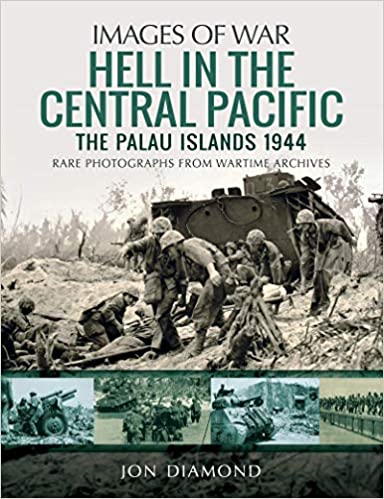Reviewed by Diana L. Ahmad, Ph.D.
Jon Diamond, a physician and author of over a dozen books about World War II, has produced yet another photo collection about the battle to beat the Japanese in the Pacific. While the United States won the two-month long campaign in the Palau Islands, the conflict proved deadly to both the Americans and the Japanese. The benefits of this campaign remain questionable. Using extensive photographic collections from the National Archives and the United States Army Military History Institute (sometimes referred to as the Army Heritage and Education Center), Diamond illustrates the Pacific road to Palau starting in the 1930s. The book includes photos of Guadalcanal, New Guinea, Guam, Kwajalein, and Roi-Namur, for example, but stresses the conflict on Peleliu.
Diamond provides brief, albeit detailed, accounts of the battles which led to the United States Navy, Marines, and Army turning their attention to potential Japanese opposition against General Douglas MacArthur’s 1944 retaking of the Philippines. Located just east of Mindanao, Peleliu and Anguar Islands were heavily fortified and could potentially have presented a significant threat to MacArthur’s plans, though eventually MacArthur chose to retake the Philippines by way of Leyte.
The photographs, accompanied by detailed descriptions, illustrate the difficult terrain of the islands as well as the weapons used by the United States Marines and Army troops who fought there. There are few photographs showing the Japanese side of the conflict. Diamond does include a few photographs of the elaborate tunnel system hidden in Umurbrogol Mountain on Peleliu, though the majority of those were taken after the Japanese defeat.
Hell in the Central Pacific should meet most readers’ expectations for a photo collection of the conflict, though photographs from the Japanese side showing what they experienced in the Palau battles would have enhanced the book. Discussing the Army’s contributions to the battle was important and reflects the author’s research at the Military History Institute, though perhaps he should have visited the Marine Corps Archives at Quantico, Virginia, as well. Additionally, a brief explanation of who the photographers were and what experiences they had while filming the fighting would have been beneficial. The author includes a few photographs taken in the communities of Saipan Town and Asias, yet there are no pictures of the islanders. Had the islanders been removed from the islands prior to the battle or did they remain hidden somewhere, perhaps moved to Babelthuap? Still, there is little to distinguish battles on one Pacific island or atoll from another, so Diamond’s explanations proved important to an overall understanding of the conflict and its contribution to victory over the Japanese. Ultimately, the book provides a good look at the fighting in the Palau group and will certainly give readers a thorough understanding of the difficulties of war.
Diana L. Ahmad is a Curators’ Distinguished Teaching Professor with the Missouri University of Science and Technology’s Department of History and Political Science. She is also a Book Review Editor for Nevada State Historical Quarterly.
Hell in the Central Pacific: The Palau Islands 1944 (Jon Diamond, Pen & Sword Military, Yorkshire, Great Britain, 2020)


